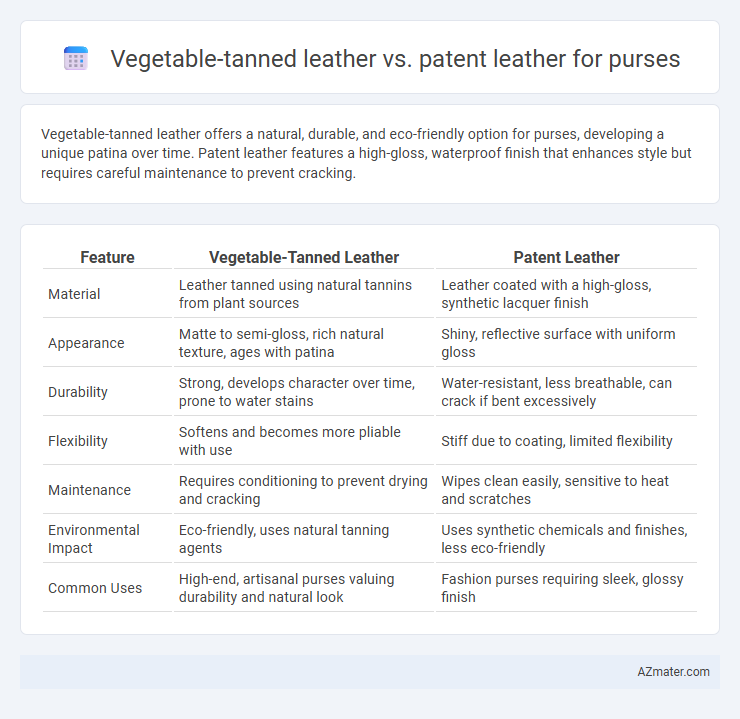Vegetable-tanned leather offers a natural, durable, and eco-friendly option for purses, developing a unique patina over time. Patent leather features a high-gloss, waterproof finish that enhances style but requires careful maintenance to prevent cracking.
Table of Comparison
| Feature | Vegetable-Tanned Leather | Patent Leather |
|---|---|---|
| Material | Leather tanned using natural tannins from plant sources | Leather coated with a high-gloss, synthetic lacquer finish |
| Appearance | Matte to semi-gloss, rich natural texture, ages with patina | Shiny, reflective surface with uniform gloss |
| Durability | Strong, develops character over time, prone to water stains | Water-resistant, less breathable, can crack if bent excessively |
| Flexibility | Softens and becomes more pliable with use | Stiff due to coating, limited flexibility |
| Maintenance | Requires conditioning to prevent drying and cracking | Wipes clean easily, sensitive to heat and scratches |
| Environmental Impact | Eco-friendly, uses natural tanning agents | Uses synthetic chemicals and finishes, less eco-friendly |
| Common Uses | High-end, artisanal purses valuing durability and natural look | Fashion purses requiring sleek, glossy finish |
Introduction: Understanding Leather Types for Purses
Vegetable-tanned leather, prized for its natural aging and durability, offers a rustic and elegant appeal perfect for classic purses. Patent leather, coated with a glossy finish, delivers a sleek, polished look that resists moisture and stains, ideal for fashion-forward designs. Choosing between these leathers depends on desired aesthetics, maintenance level, and long-term wear, influencing the purse's style and functionality.
What Is Vegetable-Tanned Leather?
Vegetable-tanned leather is crafted using natural tannins extracted from tree bark, leaves, and other plant materials, making it an eco-friendly and biodegradable option for purses. This leather type develops a unique patina over time, enhancing the purse's character and durability. Unlike patent leather, which has a glossy, synthetic finish, vegetable-tanned leather offers a matte, natural look that ages gracefully with use.
What Is Patent Leather?
Patent leather is a type of leather that features a high-gloss finish achieved through a coating process involving lacquer or plastic, giving it a shiny, reflective surface ideal for fashion accessories like purses. Unlike vegetable-tanned leather, which undergoes a natural tanning process using organic materials resulting in a more matte, textured finish, patent leather is prized for its smooth, polished look and water-resistant properties. This distinct surface makes patent leather purses easier to clean and maintain but less breathable compared to the more natural feel and aging potential of vegetable-tanned leather.
Raw Material Comparison
Vegetable-tanned leather for purses is crafted using natural tannins derived from tree bark, leaves, and other plant materials, resulting in a durable, breathable, and eco-friendly product. Patent leather, in contrast, is typically made from chrome-tanned leather coated with a high-gloss synthetic finish, offering a shiny, water-resistant surface but less natural breathability. The raw materials for vegetable-tanned leather emphasize sustainability and aging beauty, while patent leather prioritizes aesthetic appeal and surface protection through synthetic compounds.
Durability and Longevity
Vegetable-tanned leather boasts superior durability and a natural aging process that enhances its character over time, making it ideal for long-lasting purses. Patent leather features a high-gloss finish that resists water and stains but is prone to cracking and peeling with extended use. For purses requiring sustained longevity, vegetable-tanned leather offers a more robust and enduring material compared to the delicate surface of patent leather.
Appearance and Aesthetic Appeal
Vegetable-tanned leather offers a natural, matte finish with a rich patina that deepens over time, enhancing the purse's rustic and artisanal aesthetic. Patent leather features a glossy, high-shine surface that creates a sleek, polished look ideal for formal or fashion-forward styles. The choice between them impacts the overall visual appeal, with vegetable-tanned leather exuding warmth and character, while patent leather provides a bold, eye-catching statement.
Environmental Impact and Sustainability
Vegetable-tanned leather, derived from natural tannins found in tree bark and plants, offers a more eco-friendly alternative to patent leather, which is coated with synthetic plastics and chemicals that hinder biodegradability. The production process of vegetable-tanned leather minimizes harmful chemical waste and supports sustainable forestry practices, resulting in lower environmental footprints compared to the petrochemical-based components in patent leather. Purse manufacturers aiming for sustainability prioritize vegetable-tanned leather due to its biodegradability, reduced toxicity, and recyclability, making it a greener choice for conscious consumers.
Maintenance and Care Requirements
Vegetable-tanned leather requires regular conditioning with natural oils to prevent drying and cracking, and it develops a unique patina over time that needs careful preservation. Patent leather demands minimal maintenance, usually just regular wiping with a damp cloth to maintain its glossy finish, but it is prone to scuffs and scratches that can be difficult to repair. Both types of leather benefit from avoiding prolonged exposure to direct sunlight and moisture to extend the purse's longevity.
Price and Market Availability
Vegetable-tanned leather purses typically cost more due to the lengthy, eco-friendly tanning process and limited production compared to patent leather, which is more affordable and widely available because of its synthetic coating and mass manufacturing. Market availability of vegetable-tanned leather purses is often restricted to specialty boutiques and artisanal brands, whereas patent leather purses dominate mainstream retail channels and online platforms. Price fluctuations in vegetable-tanned leather depend on factors like origin and quality, while patent leather prices remain relatively stable due to standardized manufacturing.
Which Leather Is Best for Your Purse?
Vegetable-tanned leather offers durability, natural aging, and a unique patina, making it ideal for those seeking a classic, long-lasting purse with character. Patent leather provides a glossy, polished finish that resists water and stains, perfect for stylish, formal occasions requiring a sleek look. Choosing between vegetable-tanned and patent leather depends on whether you prioritize durability and natural texture or high shine and easy maintenance for your purse.

Infographic: Vegetable-tanned leather vs Patent leather for Purse
 azmater.com
azmater.com